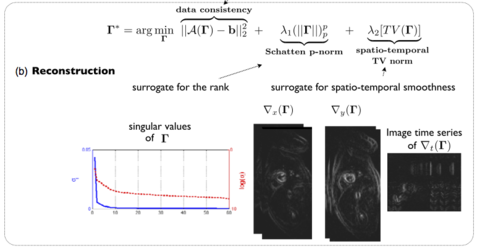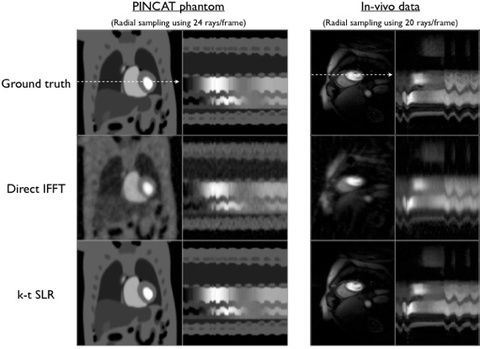Download link [kt SLR codes]
k-t SLR formulation:
k-t SLR exploits the low rank and sparsity properties of dynamic data to enable recovery from undersampled k-t measurements. k-t SLR is formulated as a spectral and sparsity regularized optimization problem below, where the Schatten p-norm is used as a surrogate for the rank of the matrix, and the spatio-temporal total variation norm is used as a surrogate for spatio-temporal smoothness of dynamic data.

Examples provided in the codes: The algorithm is demonstrated based on retorspective undersampling of a numerical PINCAT phantom and an in-vivo fully sampled dataset, both in the context of cardiac perfusion MRI. Below are some screen shots of the reconstructions along with the image time series. Please refer to Readme.pdf file in the code package for instructions on the usage of the code.

Please credit the below references, if the code is used in an abstract or a paper:
[1] S.G.Lingala, Y.Hu, E.DiBella and M.Jacob, “Accelerated dynamic MRI exploiting sparsity and low rank structure: k-t SLR”, IEEE Transactions on Medical Imaging (IEEE- TMI), pp:1042-1054, vol.30, May 2011.
[2] S.G.Lingala, Y.Hu, E.DiBella, and M.Jacob, “Accelerated myocardial perfusion imaging using improved k-t SLR”, IEEE International Symposia on Biomedical Imaging (IEEE-ISBI), 2011.
For any questions or any bug reports, please contact sajangoud-lingala@uiowa.edu or mathews-jacob@uiowa.edu.
This work is supported by NSF Awards CCF-0844812, CCF-1116067, NIH 1R211HL109710-01A1, and AHA 12 PRE11920052